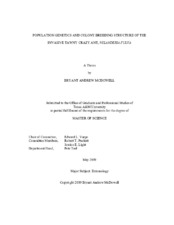| dc.description.abstract | Insects that have evolved to live socially are some of the most invasive species on the planet. Of these invaders, many are ant species whose overwhelming success in non-native habitats is possible due to several favorable attributes. Unicoloniality, a social structure adopted by many invasive ant species, is defined by the ability to form supercolonies (a group of individuals throughout a geographic area, where direct interaction of individuals from distant nests does not occur) which may span many kilometers. High queen densities within supercolonies affords an overpowering concentration of worker ants which intermix with members of adjacent colonies without intraspecific aggression, seemingly working together resulting in exponential colony growth. The tawny crazy ant, Nylanderia fulva (Mayr), was recently introduced into the southeastern United States from South America. These ants were first discovered in Texas in 2002 and were possibly introduced into Florida as early as the 1950s. Since then, this invasive ant pest has spread to all southeastern Gulf States where it outcompetes native species, reduces arthropod species diversity, and infests urban, agricultural, and natural areas. Colonies of this ant are believed to be unicolonial in invasive populations, but to date this has not been explicitly investigated. Through behavioral assays and genetic analyses, I tested the hypothesis that the tawny crazy ant is unicolonial in its invasive range and estimated the number of possible introductions into the United States. In this study, I conclude that the tawny crazy ant is, in fact, unicolonial throughout its invasive range. I found no evidence of population differentiation, even among populations hundreds of kilometers apart. I also found low levels of relatedness (r = 0) among nestmates, lack of inbreeding, and an absence of aggression between nonnestmates separated over hundreds of km. I also discovered evidence of weak isolation by distance across the Gulf States. These results show that N. fulva forms a single supercolony throughout the entire invasive range of the southeastern United States that is most likely the result of a single introduction, which then spread via human mediated dispersal and colony budding. | en |


